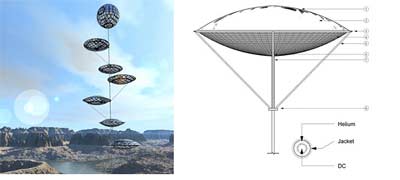Researchers in Israel say are proposing a new method of using high flying giant solar balloons to produce energy for remote towns and villages around the world.
The balloons are designed by a team from the Technion Institute of Technology and could be used to harness the sun's energy in areas that until now have been considered to distant and remote to be practical.
"The idea is to take advantage of the height dimension. When you do that, you save a lot of land resources and can get to places otherwise hard to reach," said Pini Gurfil, the concept's developer.
Pini Gurfil envisions helium-filled balloons, covered with thin solar panels, hovering as high as a few hundred yards in the air, and are connected by a wire cable to an inverter, which converts the electricity into usable electricity for homes.
Gurfil intends to have a complete system ready in about a year and his initial research showed a balloon with a 10 ft diameter could provide about one kilowatt of energy, the same as 270 square feet of traditional solar panels and he estimates that the new balloons would cost about 60% less than a traditional solar system to install and operate.
"The balloons have no carbon footprint or negative impact on the environment," Gurfil said.
John Loughhead, executive director at the UK Energy Research Centre, said there was no reason the solar balloon system could not work, but it would be practical only in a few specific circumstances.
The balloons are lined with solar panels made from durable material used in meteorological balloons, they are filled with helium and silicon insulation is used on the inside. The balloons can stay aloft for about a year before being reinflated.
They are lined with solar panels, about 0.2 mm thick, and a three-metre balloon weighs about 5.5 lb.
Joseph Cory, the research team's architect, said the final balloons will have an aerodynamic design to cancel out the wind effect and maximise sunlight. The largest balloons could be the size of zeppelins, he said.
"The vision is that we can make as many balloons as we want in a special way, like the leaves of a flower that do not shade each other," Cory said.

